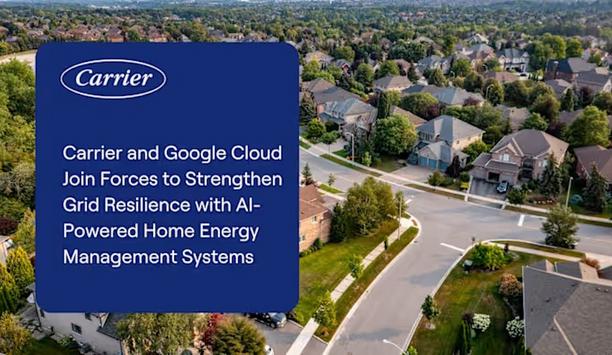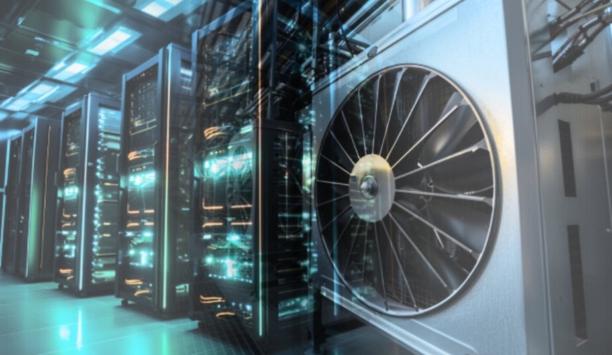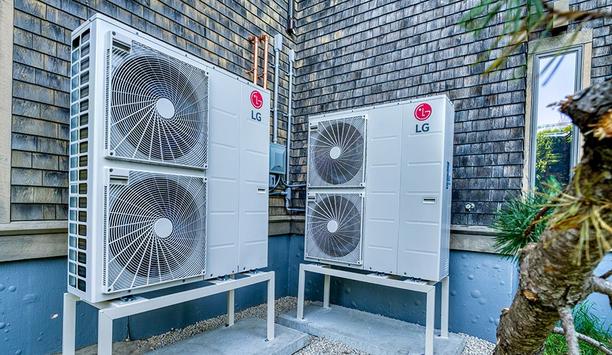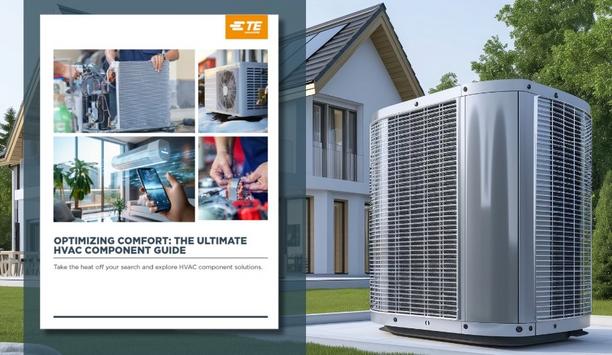Google Nest - Experts & Thought Leaders
Latest Google Nest news & announcements
Carrier Global Corporation, pioneer in intelligent climate and energy solutions, and Google Cloud are joining forces to enhance grid flexibility and support smarter energy management. Led by Carrier Energy, Carrier's new energy solutions business, this initiative will integrate Carrier's battery-enabled HVAC technology-delivered through its Home Energy Management System (HEMS) solutions-with Google Cloud's AI-powered analytics and WeatherNext AI models built by Google DeepMind and Google Research. The combined solution is expected to create intelligent, connected solutions for residential HVAC energy customers. Advancing AI-Powered Energy Management These factors present new opportunities and challenges for both utilities and consumers Electricity demand is rising across the U.S. as factors such as onshoring, electrification of transport and adoption of AI converge. These factors present new opportunities and challenges for both utilities and consumers. By leveraging real-time energy forecasting and intelligent grid interaction, Carrier and Google Cloud are working to ensure Carrier's HEMS technology will help balance supply and demand across the grid. Google's AI-powered WeatherNext models For homeowners, this means they can store energy in batteries and use it during peak demand periods, when electricity costs are typically higher. Google's AI-powered WeatherNext models further optimize HVAC operation, enabling greater efficiency and potential cost savings. This will help promote greater availability, reliability and affordability for energy users. benefits for the local grids Carrier and Google Cloud will collaborate on innovative solutions to help unlock capacity This initiative helps facilitate Google's ambition to create new carbon-free energy solutions that support reliable and resilient grid operations. It also supports Carrier's goal of helping its customers avoid more than one gigaton of greenhouse gas emissions by 2030. Under this partnership, Carrier and Google Cloud will collaborate on innovative solutions to help unlock capacity and grid expansion in U.S. markets. By working together, Carrier and Google Cloud aim to create scalable benefits for the local grids where Carrier customers live. Clean energy solutions "Across the country we see an opportunity to build resilience in communities and scale innovative, clean energy solutions that foster economic growth," said Caroline Golin, global head of Energy Market Development and Innovation at Google. "Through collaboration with Carrier, and across the industry, we hope to create the change that brings benefits for all." Unlocking Grid Efficiency Carrier's next-generation heat pump will feature battery storage, intelligent energy forecasting First announced at Climate Week NYC last fall, Carrier's next-generation heat pump will feature battery storage, intelligent energy forecasting and grid-interactive capabilities to help utilities flatten demand peaks and enhance energy efficiency. By integrating Carrier's HEMS technology with Google Cloud's BigQuery, Vertex AI, generative AI solutions, and WeatherNext's forecasting models, the system will intelligently manage energy flows in real time-charging, discharging and redirecting energy based on grid conditions, energy demands and weather forecasts-contributing to a more balanced and sustainable energy grid. Integrating Carrier's HEMS technology Homeowners using stored battery energy during peak periods can help reduce strain on the grid when electricity demand is highest and energy supplies tend to have a higher carbon footprint. The project will roll out in phases through 2027, with a focus on scaling nationwide adoption thereafter. "Our energy systems must evolve to be more intelligent, flexible and economically efficient," said Hakan Yilmaz, chief technology and sustainability officer at Carrier and head of the company's new energy business. "By integrating Carrier's HEMS technology with Google Cloud's AI and analytics, we aim to help increase the efficiency of existing energy infrastructure-reducing grid congestion, unlocking greater energy utilization and contributing to economic growth." Carrier's intelligent HVAC systems Homeowners using stored battery energy during peak periods can help reduce strain on the grid "Carrier's innovative approach to energy grid management solutions will help create a lasting positive impact on the U.S. energy landscape." "By integrating Google Cloud's AI and analytics with Carrier's intelligent HVAC systems, we are creating solutions that meaningfully contribute to a more efficient and resilient energy ecosystem," said Kyle Jessen, managing director, Energy Sector, Google Cloud. A Smarter, More Resilient Energy Future As utilities, businesses and consumers adapt to an evolving energy landscape, AI-driven energy optimization will play a critical role in ensuring grid resilience and supporting electrification. Through this collaboration, Carrier and Google Cloud are taking a bold step toward a smarter, more efficient and AI-powered energy ecosystem-one that not only benefits homeowners but also supports the next generation of technology infrastructure.
Plumbing-Heating-Cooling Contractors National Association (PHCC) unveils Jeff Butler and Mary Kelly as the keynote speakers for CONNECT 2024 in Birmingham, Alabama, October 7-10, at the Birmingham Jefferson Convention Complex. Jeff Butler is a workplace strategist, who has offered expertise to help companies like Amazon, Google, and John Deere foster a harmonious and high-performing workplace. Butler will present a keynote address, “Building an Effective Multi-Generational Workplace.” He will also lead a breakout session on the topic of “Winning the Talent War.” Practical strategies and innovative solutions Mary Kelly is a Council of Peer Award of Excellence speaker, best-selling author and Navy commander Mary Kelly is a Council of Peer Award of Excellence speaker, best-selling author and Navy commander. At CONNECT, Kelly will share various stories and experiences of interest to p-h-c contractors during her keynote address, “Why Leaders Fail and the 7 Prescriptions for Success.” Kelly will also lead a breakout session, “Master Your World,” where she will emphasize effective tactics, practical strategies and innovative solutions that are tailored to dilemmas faced by pioneers. “I know that many attendees, including myself, are anticipating the remarks that Jeff and Mary will share,” says Joe Cornetta, PHCC national president and co-owner of Cornetta Brothers, Inc., Elmont, New York. “We are excited to have these two pioneers join us and help offer invaluable insights to the industry.” Information on education sessions For more details, including the schedule-at-a-glance, visit the website. This site offers information on education sessions, speakers, exhibitors, registration and hotel reservations, as well as the many attractions of Birmingham, known as “The Country’s Best Kept Secret.”
Danfoss and Google have announced a strategic partnership to make use of the latest advances in artificial intelligence (AI) and promote energy-efficient solutions in data centers. Under the partnership, Danfoss, the Danish multinational engineering group, will use Google Cloud’s generative AI capabilities to optimize the customer experience, streamline internal work processes and improve productivity across the organization. This can be done, for example, by using gen AI to collect and surface information, automate knowledge, generate product descriptions, and create solutions with chatbots in e-commerce. Danfoss Turbocor® compressors Danfoss is working with Google to execute sustainable cooling systems for data centers As a global pioneer in energy-efficient solutions, Danfoss is working with Google to implement sustainable cooling systems for data centers and to design systems that reuse the excess heat produced by data centers. Danfoss Turbocor® compressors provide highly reliable, highly efficient solutions when expertly applied by OEM partners and are being installed by Google to improve energy efficiency and decarbonize heating and cooling systems in data centers. new agreement and broader partnership Meanwhile, Danfoss’ heat reuse modules will make it possible for Google to capture and reuse heat produced by data centers, providing a renewable energy source to supply heating on-site and to neighboring commercial and residential buildings, communities, and industries that need heat for their processes. Going forward, Danfoss' expertise in decarbonization solutions will be used to an even greater extent to advance data center sustainability in Europe, North America, and beyond. The new agreement, announced during the AHR Expo in Chicago, USA, builds on an existing collaboration between the two companies, which were among the founders of the Net Zero Innovation Hub in Fredericia, Denmark, announced in September 2023, where a number of major players joined forces to accelerate the green transformation of data centers. Danfoss and Google are now taking a step further by entering into a broader partnership. Decarbonize data centers Jürgen Fischer, President, Danfoss Climate Solutions, said: “At Danfoss, we want to revolutionize how we build and decarbonize data centers together with our customers. When we partner up across industries like we have done with Google, we accelerate this development towards building better and more sustainable data centers-using technologies available today.” Deliver AI innovation Google Vice President of Data Center Innovation, J.P. Clausen, is excited about the collaboration. “This is a great example of a partnership utilizing each other’s strengths and using technology to optimize the customer experience, increase productivity and reach sustainability goals." "Danfoss is a pioneer in energy efficiency, and these solutions help support Google’s 2030 goal of running our data centers on carbon-free energy 24/7. We’re happy to deliver AI innovation through Google Cloud, enabling businesses like Danfoss to operate in new and smarter ways,” says J.P. Clausen.
Insights & Opinions from thought leaders at Google Nest
The computing power we know as the Internet actually resides in millions of data centers that house rows and rows of computer servers. And each data center represents a unique HVAC challenge: How to keep the equipment cool, the air pure and the humidity low. Providing the ideal operating conditions for a room full of computers requires the best that the HVAC market can offer. Data centers come in all shapes, sizes and configurations. Some are huge facilities that serve the needs of giants, such as Google, Amazon and Microsoft. Others are smaller and might contain the servers for a single company. In every case, there is expensive equipment operating, creating enormous amounts of heat and there is important data to be preserved. Air quality and temperature monitoring Data centers have a narrower range of acceptable environmental factors when compared to typical buildings Air quality and temperatures are monitored around the clock, and even small discrepancies can undermine the whole operation. Data centers have a narrower range of acceptable environmental factors when compared to typical buildings. ASHRAE provides guidelines and best practices for mission-critical facilities, which should be followed by any contractor working with data centers. The layout of a data center is an important consideration – what is the location of servers and other key equipment? Appropriate parameters in various zones ensure correct temperatures and humidity levels. Managing power loads Access must be maintained to the electrical infrastructure and supplies, and attention must be paid to electric loads. Typically, an HVAC system uses its own electrical supply, separate from the system that the servers depend on. This approach helps with managing power loads. Often server rooms have raised floors to provide technicians access to the infrastructures. Fans placed under the floor can discharge air in a wider pattern for more uniform cooling. Server rooms may also have higher ceilings to provide room for large equipment racks. These features can impact air flow, temperature and humidity and should be incorporated into HVAC system designs. ‘Hot aisle, cold aisle’ approach Managing higher heat loads of computer servers arranged in rows at data centers can use a ‘hot aisle, cold aisle’ approach. Cold air intakes and hot air exhausts face alternating rows. Because of moisture concerns, only plumbing that relate to fire suppression should be located near the server rooms. Server rooms typically do not have windows or outside doors or outside-facing walls. Air filtration For air quality, filters eliminate the smallest particles such as dust or pollen. HEPA filters are effective For air quality, filters eliminate the smallest particles such as dust or pollen. HEPA filters are effective. Other factors include new motor types, fewer moving parts, and more sensors to provide predictive maintenance. Preventive maintenance is a better approach than facing the possible dire consequences of an emergency. Keeping spare parts on hand is a good way to minimize risk. Variable-speed fans save energy, and they use motors that do not require belts, pulleys or bearing hardware for cleaner operation and less contamination, and less frequent maintenance. However, monthly HVAC inspections should be implemented to ensure maximum data center uptime. Mission-critical HVAC systems Mission-critical HVAC systems for data centers fall into two categories. One is Computer Room Air Conditioners (CRAC), which use compressors and are deployed for perimeter cooling. The other is Computer Room Air Handlers (CRAH), which use water from a centralized chiller and a control valve to provide cooling. Stand-alone ultrasonic units take the place of internal humidifiers on CRAC and CRAH units.
Data is playing an increasingly important role in smart buildings. Analysis of building system data is guiding an expansion of capabilities in the smart building environment, making building systems - including HVAC - more efficient, effective and smarter. The growth of intelligence in the HVAC market was among the more prominent industry trends in 2020. This article will revisit some of the year’s most popular articles on HVACinformed.com that focused on the trend toward more intelligent systems. "I don’t think many would disagree that the most talked about trend in the HVAC market is smart technology,” says Chris Windass of Incentiv Tec in an HVACinformed.com Expert Panel Roundtable article. “Smart technology like mobile apps allow building managers to control HVAC technology from one centralized point. With this smart technology, HVAC will be able to identify and alert building managers when maintenance is needed or assets have failed to operate.” smarter building technology A Johnson Controls survey found that 77% of organizations planned to make investments in energy efficiency and smarter building technology in 2020. “A complete overhaul of legacy systems is not necessary as small investments today can help position a facility to more easily adopt technologies at scale in the future,” says Lisa Brown, Senior National Director of Municipal Infrastructure and Smart Cities at Johnson Controls. More Intelligence in Home Systems Google’s Nest smart thermostat is offering a new capability that will alert homeowners of problems “As a first step, it’s important for building owners to conduct an assessment and establish a strategy that defines a comprehensive set of requirements and prioritizes use-cases and implementations. From there, incremental investments and updates can be made over a realistic timeline.” Smart systems are also a big part of residential HVAC systems. For example, Google’s Nest smart thermostat is offering a new capability that will alert homeowners of problems with the operation of their HVAC systems based on artificial intelligence (AI) algorithms that analyze system performance. The technology will empower Nest Learning thermostats to provide “early warning” of HVAC problems and even direct homeowners to a repair company. Remote Troubleshooting Emerges Sensors are another element of smart buildings. The Internet of Things (IoT) has enabled more sensors of different types to be deployed in more locations throughout the building easier than ever before. The point of installing and using IoT sensors is to gain deeper insight into how buildings are performing, and ensure buildings are healthier, more productive for people to work in, more effective to run and more energy efficient. In-room sensors, such as temperature, air quality and occupancy, work with the IoT to improve building performance. The benefits of IoT sensors are that they are easy to install, both physically and from a commissioning perspective. Remote troubleshooting is another smart capability that is generating interest. CoolAutomation’s Remote HVAC Service Solution enables HVAC service providers to remotely troubleshoot issues by analyzing real-time and historic data trends and analysis. Communicating in Smart Buildings They receive automatic error and anomaly notifications in their office or on their mobile phones They receive automatic error and anomaly notifications in their office or on their mobile phones. “The remote service solution provides the tools that HVAC service providers need to offer remote services to their existing clients while attracting new customers who understand the value of remote service for their business,” says Roy Muchtar, VP of Products at CoolAutomation. Communication is a central aspect of smart building systems, and now there’s a better option: a high-speed wireline communication standard called HD-PLC that is developed specifically for today’s industrial IoT and smart building applications. In 2017, after careful evaluation of various technologies, LonMark International adopted HD-PLC as its new channel standard. smart home standards And last October, the Consumer Technology Association (CTA) approved ANSI/CTA 709.8 LON HD-PLC (High Definition Power Line Communication) as a new standard by the American National Standards Institute (ANSI). Also related to communication, the Zigbee Alliance seeks to promote collaboration in the Internet of Things by creating, evolving, and promoting universal open standards that enable all objects to connect and interact. A quick search also provides a manual, wiring diagram and video training content for that specific unit Their effort took off when Amazon, Apple, Google and the Zigbee Alliance announced an industry working group in December 2019 to take the “best of market” technologies from leading smart home standards, portfolios and ecosystems and to develop a “super spec” that will be open, inclusive and a significant industry shift in the smart home market. The Project Connected Home over IP (CHIP) is looking to unify the environment, under one technology, one certification program and one logo. Training Technicians Using Technology Technology is also helping to fill the skills gap in the HVAC market. The XOi Vision platform helps on-site HVAC technicians in three ways. One is to “capture” images and videos. A technician can take a picture (with a smart phone or tablet), and the system’s machine learning can extract the text from the nameplate of a unit in the field, interpret the type of name plate, and provide full model number, serial number and other information about the unit, which is relayed automatically to the technician in a text message. A quick search also provides a manual, wiring diagram and video training content for that specific unit.
As the Internet of Things (IoT) has evolved, the need has become obvious for stronger unity among brands and ecosystems to enable products within smart environments to work together more easily. Working to serve that need is the Zigbee Alliance, which seeks to promote collaboration in the Internet of Things by creating, evolving, and promoting universal open standards that enable all objects to connect and interact. Their effort took off when Amazon, Apple, Google and the Zigbee Alliance announced an industry working group in December 2019 to take the “best of market” technologies from leading smart home standards, portfolios and ecosystems and to develop a “super spec” that will be open, inclusive and a significant industry shift in the smart home market. smart home automation system “Zigbee Alliance has been for a while now working on openness and interoperability, which has led us to the Project Connected Home over IP (CHIP), which is looking to unify the environment, under one technology, one certification program and one logo,” says Chris LaPré, Zigbee Alliance’s IoT Solutions Architect. “It really does fuel IoT possibilities, whether in HVAC or any other sectors.” There is a stronger need for unity, which is why we are developing Project Connected Home over IP" Project CHIP is a royalty-free connectivity standard that unifies brands and ecosystems into a single smart home automation system that operates any other technology based on Internet Protocol (IP). The intent is to simplify product development for device manufacturers, broaden consumer choice, and to ensure easy discoverability, deployment and engagement to fuel connected living. unifies that environment “We have noticed that, as the IoT has evolved, there is a stronger need for unity, which is why we are developing Project Connected Home over IP,” says Jon Harros, Zigbee Alliance’s Director of Certification and Testing Programs. “It fits with the Zigbee Alliance’s goal to unify systems, and to focus on everyone using the same application at the top. It unifies that environment, whether you are integrating your system with Amazon Echo devices or connecting to Google Home.” Participating in development of Project CHIP are 125 companies of various types from around the world working together with more than 1,100 of their experts serving across sub-committees to formulate specifications and fine-tune the project. Although the technology is being developed for the home market, the specifications have been formulated with an eye toward expanding into the commercial market in the future. home system technologies Development of open, interoperable systems provides greater freedom for consumers to choose among the many technology choices on the market, without being tied to a single brand or ecosystem. Zigbee Alliance certifications and memberships span the globe, with roughly a third in Europe, a third in North America and a third in Asia. Involvement in Europe is slightly higher than the other regions. Alliance members represent manufacturing sites all over the world. Project CHIP is a newer initiative of the Zigbee Alliance, which previously developed Zigbee Pro to enable home system technologies to operate using IEEE 802.15.4 wireless signals on the 2.4GHz radio band over a self-healing true mesh network. The original Zigbee protocol is used for many applications around the world, including HVAC. smart temperature devices HVAC developers who have specific use cases should have a look at the work of the alliance Members of the Zigbee Alliance include HVAC companies such as Lennox, Stelpro and Belimo, among others. Carrier is a recent company that has joined the Zigbee Alliance. Smart thermostats, including the popular Ecobee, have used the Zigbee protocol. More than 100 different devices have been certified as thermostats or smart temperature devices. Harros urges other HVAC companies to become more involved with the Alliance. “We want them to come and have a look to see what we are doing and get involved,” he says. “This is where the work is being done as we unify the environment and bring together all the devices and ecosystems to work together.” HVAC developers who have specific use cases should have a look at the work of the alliance, he adds. certification transfer program Among the strengths of the Zigbee Alliance are years of experience certifying products, which includes testing them and confirming that they comply with the promoted specifications and functionality. The specifications are open standards that are developed in cooperation with all the companies that are Zigbee Alliance members. Another route is the certification transfer program, in which a company chooses a certified white-label product, becomes a member of the Alliance, and then rebrands the product while retaining the certification. “It helps them get products on the market quickly while they build their own knowledge base,” says Harros. "All our work is focused on standardizing the behavior and functionality of products and making sure everyone is following the same standard to get interoperability,” says Harros. “Members all contribute to the standards.”
Leveraging Radiant And Hydronics To Help Achieve Decarbonization Goals
DownloadSealed Connectors In Harsh Environments
DownloadPowering And Cooling Next Generation Data Centers
DownloadDebunking Myths To Promote A Bright Future For Heat Pumps
DownloadOptimizing Comfort: The Ultimate HVAC Component Guide
Download













